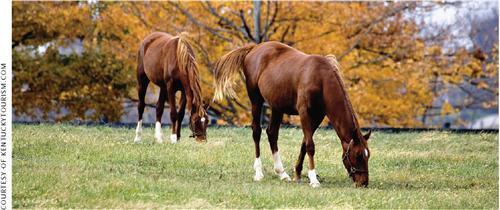Sign up for the Family Tree Newsletter Plus, you’ll receive our 10 Essential Genealogy Research Forms PDF as a special thank you!
Get Your Free Genealogy Forms
"*" indicates required fields

Out of the gates
Before white settlement, Shawnee Indians from north of the Ohio, and Cherokee and Chickasaw from south of the Cumberland River fought for control over the rich Kentucky hunting grounds. But when settlers came from the East, drawn by rich game and richer soil, Indian attacks turned on the new outposts. In 1763, England, having won French possessions east of the Mississippi in the French and Indian War, tried to stabilize relations with the Indians by forbidding colonists from settling west of the Appalachians.
Treaties opened Kentucky to settlement, and in 1775, Boone and the Transylvania Company blazed Boone’s Trace (later the Wilderness Road) from western Virginia through the Cumberland Gap. Once word about the “Kentucky Paradise” got out, a land rush was on, despite numerous Indian raids on Boonesborough, Harrodsburg and other early settlements. Boone himself was captured in 1778 while making salt at Lower Salt Spring, but he escaped a few months later in time to warn the Transylvania Fort of an impending attack.
The Virginia legislature annexed Kentucky in 1772, stashing it in Fincastle County. In 1776, it became Kentucky County. You may need to extend your records search into those areas, as well as Virginia’s Montgomery County, one of three counties to succeed Fincastle in 1777. Another point to keep in mind: since Virginia at the time encompassed everything west of its modern boundaries, your early “Kentucky” ancestors may have lived in what’s now Indiana, Illinois, West Virginia or Ohio.
Race for land
Kentucky finally became a state in 1792. All the hand-changing makes land records there somewhat complicated. It’s mostly a state-land state with a small bit of public land, and early patents could list Virginia or Kentucky as the grantor. You’ll find plenty of land title litigation in the Bluegrass State due to a proclivity for do-it-yourself surveying, settlers’ tendency to move in and our during the Indian wars and Virginia’s granting land so far away from its central government. Even after Kentucky statehood, Virginia gave away Kentucky land in the form of military bounty warrants.
The Library of Virginia Web site has pre-1779 Virginia land patents <www.lva.lib.va.us/whatwehave> (click Land Records). Patents recorded at the Kentucky land office from 1782 to 1924 are indexed in Williard Rouse Jillson’s The Kentucky Land Grants (Genealogical Publishing Co.).
The Kentucky land office also offers a wealth of online records <sos.ky.gov/land/search>. Search an index to 4,748 Revolutionary War veterans’ bounty-land warrants by warrant number, soldier or assignee (someone who purchased or inherited a warrant shortly after issue). Click for an image of the original warrant and any associated patent documents. If there’s no patent, you’ll get research suggestions. You also can search nonmilitary land records, including 23,000 Virginia treasury-issued warrants.
A portion of western Kentucky acquired in 1818 is public land. The “West of Tennessee River patents” from this Jackson Purchase area aren’t online, though you can use the land office’s online locator tool to find a tract on a map. The patents are indexed in Kentucky Land Grants.
The Kentucky Department for Libraries and Archives (KDLA) has microfilmed deed books; see the end of this article for information on submitting a research request. The Church of Jesus Christ of Latter-day Saints Family History Library (FHL) has microfilmed copies for some counties; you can rent them through a branch Family History Center (see <www.familytreemagazine.com/fhcs> to find one near you).
Contested finish
The issue of slavery carried less weight in Kentucky, where small farms weren’t part of the plantation economy, than in the big cotton states further south. The Bluegrass State remained in the Union during the Civil War, but loyalties were torn in this border state. Confederate forces moved into southern Kentucky, while Union troops crossed the Ohio and occupied Paducah. More than 30,000 Kentuckians fought for the Confederacy; about 64,000 served with the Union.
Names of soldiers from both sides are in the Civil War Soldiers and Sailors System <www.itd.nps.gov/cwss>. Also search the rosters at <www.geocities.com/area5l/lair/3680/cw/cw-ky html>. KDLA has more Civil War resources, such as military prison registers, Confederate veterans’ home papers and microfilmed service records for those in state units, as well as records for Kentucky militia members from earlier wars. (See <www.kdla.ky.gov/resources/kycivilwarresearch. htm> for information.) Service records for soldiers from federal units are available through the National Archives and Records Administration <archives.gov/order>.
The Civil War and other events resulted in a number of “burned” courthouses. See a list at <www.kdla.ky.gov/resources/kycourthousedisasters.htm>. But don’t give up if your ancestor lived in one of those counties. Some records might have been spared, and you can use substitute sources such as newspapers, church records and military records. Look for records in parent and neighboring counties, too-sometimes the courthouse in another county was closer to your relative.
Running the numbers
Kentucky didn’t take any state censuses, but US censuses of Kentucky are available every 10 years from 1810 on. Search them on Ancestry.com <Ancestry.com > ($155.40 per year), or free through libraries that subscribe to HeritageQuest Online or Ancestry Library Edition.
You can use indexed tax lists, on microfilm at KDLA and the FHL, to substitute for the 1790 and 1800 censuses. Some are in Early Kentucky Tax Records (Genealogical Publishing Co.). Depending on the county, tax lists may be available up to 1840.
Most of the 1890 census was destroyed in a fire, of course, including half of Kentucky’s special schedule listing Union Civil War veterans. You’ll find the remainder along with other federal census records. More census specifics are available in KDLA’s guide <www.kdla.ky.gov/resources/censusrecords.htm>.
Kentucky mandated that its counties record births and deaths in 1911. You can request post-1911 records from the vital-records office. KDLA holds pre-1911 birth and death records from the cities of Louisville, Lexington, Covington and Newport (which passed record-keeping laws before the state did) and the whole state’s 191l-to-1955 death records.
Statewide registration of marriages and divorces in Kentucky didn’t begin until June 1958. To get copies of earlier records, contact the county clerk where your ancestors married. For divorces, go to the clerk of the circuit court that issued the decree.
Document derby
Another valuable source of records for tracing Kentuckians is in a collection called the Draper Manuscripts <https://www.wisconsinhistory.org/Records/Article/CS4103>.; It’s named for State Historical Society of Wisconsin librarian Lyman Copeland Draper, who gathered almost 500 volumes of papers on the history of the trans-Allegheny West from the 1740s through 1810s. Today, the area includes parts of the Carolinas, Virginia, Georgia, Alabama, the entire Ohio Valley and the Mississippi Valley. In the vast store are interviews with pioneers, accounts of the siege of Bryan’s Station and the Battle of Blue Lick, petitions from settlers and papers about the early settlement of Lexington.
The Wisconsin society owns the originals; papers focusing on Kentucky are coded CC. More than 90 US libraries (including the FHL) have complete sets on microfilm. If yours isn’t one, request films through interlibrary loan.
Going the distance
For a small fee ($10 for Kentucky residents, $15 for others), KDLA will search for census schedules, vital records, court and property documents, and military records. Fill out a request form at <www.kdla.ky.gov/research.htm#family>. With this help and Kentucky’s many other genealogy resources, the run for your Bluegrass State family tree will stay right on track.
From the March 2008 Family Tree Magazine
ADVERTISEMENT


